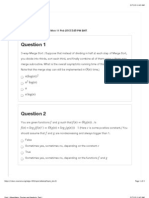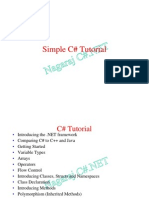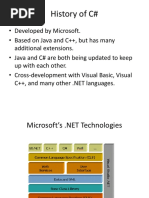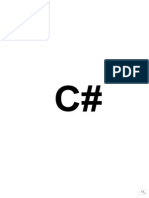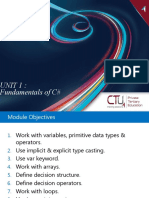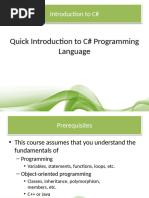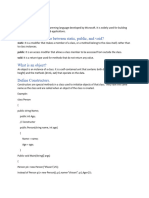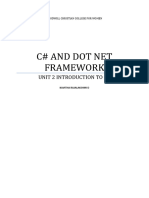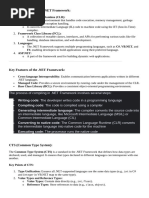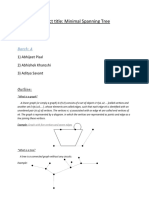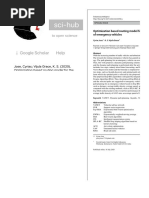0 ratings0% found this document useful (0 votes)
C# Introduction: by Prof. Vasanti Dutta
C# Introduction: by Prof. Vasanti Dutta
Uploaded by
sonuC# is a multi-paradigm programming language developed by Microsoft for its .NET Framework. It supports imperative, functional, generic, object-oriented and component-oriented programming. C# is intended to be a simple, modern, general-purpose language and its most recent version is 4.0. It was influenced by languages like Java, C++ and Object Pascal.
Copyright:
© All Rights Reserved
Available Formats
Download as PPT, PDF, TXT or read online from Scribd
Download as ppt, pdf, or txt
C# Introduction: by Prof. Vasanti Dutta
C# Introduction: by Prof. Vasanti Dutta
Uploaded by
sonu0 ratings0% found this document useful (0 votes)
C# is a multi-paradigm programming language developed by Microsoft for its .NET Framework. It supports imperative, functional, generic, object-oriented and component-oriented programming. C# is intended to be a simple, modern, general-purpose language and its most recent version is 4.0. It was influenced by languages like Java, C++ and Object Pascal.
Original Description:
c shrp
Original Title
C-sharp1
Copyright
© © All Rights Reserved
Available Formats
PPT, PDF, TXT or read online from Scribd
Share this document
Did you find this document useful?
Is this content inappropriate?
C# is a multi-paradigm programming language developed by Microsoft for its .NET Framework. It supports imperative, functional, generic, object-oriented and component-oriented programming. C# is intended to be a simple, modern, general-purpose language and its most recent version is 4.0. It was influenced by languages like Java, C++ and Object Pascal.
Copyright:
© All Rights Reserved
Available Formats
Download as PPT, PDF, TXT or read online from Scribd
Download as ppt, pdf, or txt
0 ratings0% found this document useful (0 votes)
C# Introduction: by Prof. Vasanti Dutta
C# Introduction: by Prof. Vasanti Dutta
Uploaded by
sonuC# is a multi-paradigm programming language developed by Microsoft for its .NET Framework. It supports imperative, functional, generic, object-oriented and component-oriented programming. C# is intended to be a simple, modern, general-purpose language and its most recent version is 4.0. It was influenced by languages like Java, C++ and Object Pascal.
Copyright:
© All Rights Reserved
Available Formats
Download as PPT, PDF, TXT or read online from Scribd
Download as ppt, pdf, or txt
You are on page 1/ 23
C# Introduction
By Prof. Vasanti Dutta
C#
• C# (pronounced "see sharp") is a multi-paradigm
programming language encompassing imperative,
functional, generic, object-oriented (class-based), and
component-oriented programming disciplines. It was
developed by Microsoft within the .NET initiative and
later approved as a standard by Ecma (ECMA-334) and
ISO (ISO/IEC 23270). C# is one of the programming
languages designed for the Common Language
Infrastructure.
• C# is intended to be a simple, modern, general-purpose,
object-oriented programming language. Its development
team is led by Anders Hejlsberg. The most recent
version is C# 4.0, which was released in April 12, 2010.
C# (programming language)
• C# Usual file extensions : . Cs
• Paradigm multi-paradigm: structured, imperative, object-oriented, event-driven, functional
• Appeared in 2001
• Designed & Developer by Microsoft
Stable release 4.0 (April 12, 2010)
• Typing discipline static, dynamic,strong, safe, nominative
• Major implementations.NET Framework, Mono, DotGNU
• Influenced by Java, C++, Eiffel, Modula-3, Object Pascal
• Influenced D, F#, Java 5, Nemerle, Vala
• C# (pronounced "see sharp") is a multi-paradigm programming
language encompassing imperative, functional, generic, object-
oriented (class-based), and component-oriented programming
disciplines. It was developed by Microsoft within the .NET initiative
and later approved as a standard by Ecma (ECMA-334) and ISO
(ISO/IEC 23270).
• C# is one of the programming languages designed for the Common
Language Infrastructure.
• C# is intended to be a simple, modern, general-purpose, object-
oriented programming language. Its development team is led by
Anders Hejlsberg. The most recent version is C# 4.0, which was
released in April 12, 2010.
Features of C# 1/4
• There are no global variables or functions. All methods and
members must be declared within classes. Static members of public
classes can substitute for global variables and functions.
• Local variables cannot shadow variables of the enclosing block,
unlike C and C++. Variable shadowing is often considered confusing
by C++ texts.
• C# supports a strict Boolean datatype, bool. Statements that take
conditions, such as while and if, require an expression of a type that
implements the true operator, such as the boolean type. While C++
also has a boolean type, it can be freely converted to and from
integers, and expressions such as if(a) require only that a is
convertible to bool, allowing a to be an int, or a pointer. C# disallows
this "integer meaning true or false" approach on the grounds that
forcing programmers to use expressions that return exactly bool can
prevent certain types of common programming mistakes in C or C++
such as if (a = b) (use of assignment = instead of equality ==).
Features of C# 2/4
• In C#, memory address pointers can only be used within blocks
specifically marked as unsafe, and programs with unsafe code need
appropriate permissions to run. Most object access is done through
safe object references, which always either point to a "live" object or
have the well-defined null value; it is impossible to obtain a
reference to a "dead" object (one which has been garbage
collected), or to a random block of memory. An unsafe pointer can
point to an instance of a value-type, array, string, or a block of
memory allocated on a stack. Code that is not marked as unsafe
can still store and manipulate pointers through the System. IntPtr
type, but it cannot dereference them.
• Managed memory cannot be explicitly freed; instead, it is
automatically garbage collected. Garbage collection addresses the
problem of memory leaks by freeing the programmer of
responsibility for releasing memory which is no longer needed.
• In addition to the try...catch construct to handle exceptions, C# has a
try...finally construct to guarantee execution of the code in the finally
block.
Features of C# 3/4
• Multiple inheritance is not supported, although a class can
implement any number of interfaces. This was a design
decision by the language's lead architect to avoid
complication and simplify architectural requirements
throughout CLI.
• C# is more type safe than C++. The only implicit
conversions by default are those which are considered
safe, such as widening of integers. This is enforced at
compile-time, during JIT, and, in some cases, at runtime.
There are no implicit conversions between booleans and
integers, nor between enumeration members and integers
(except for literal 0, which can be implicitly converted to
any enumerated type). Any user-defined conversion must
be explicitly marked as explicit or implicit, unlike C++ copy
constructors and conversion operators, which are both
implicit by default.
Features of C# 4/4
• Enumeration members are placed in their own scope.
• C# provides properties as syntactic sugar for a common
pattern in which a pair of methods, accessor (getter) and
mutator (setter) encapsulate operations on a single
attribute of a class.
• Full type reflection and discovery is available.
• C# currently (as of 3 June 2008) has 77 reserved words.
• Checked exceptions are not present in C# (in contrast to
Java). This has been a conscious decision based on the
issues of scalability and version ability
C# Basics
• Basic syntax
• Describes the basics in how the applications you write will be
interpreted.
• Variables
• The entities used to store data of various shapes.
• Operators
• Summarizes the operators, such as the '+' in addition, available in
C#.
• Data structures
• Enumerations, structs, and more.
• Control statements
• Loops, conditions, and more. How the program flow is controlled.
Data Types: Value types
• Value types : Value types are plain aggregations of data. Instances
of value types do not have referential identity nor a referential
comparison semantics - equality and inequality comparisons for
value types compare the actual data values within the instances,
unless the corresponding operators are overloaded. Value types are
derived from System.ValueType, always have a default value, and
can always be created and copied. Some other limitations on value
types are that they cannot derive from each other (but can
implement interfaces) and cannot have an explicit default
(parameterless) constructor. Examples of value types are some
primitive types, such as int (a signed 32-bit integer), float (a 32-bit
IEEE floating-point number), char (a 16-bit Unicode code unit), and
System.DateTime (identifies a specific point in time with
nanosecond precision). Other examples are enum (enumerations)
and struct(user defined structures).
Data Type: Reference types
• Reference types have the notion of referential identity - each
instance of a reference type is inherently distinct from every other
instance, even if the data within both instances is the same. This is
reflected in default equality and inequality comparisons for reference
types, which test for referential rather than structural equality, unless
the corresponding operators are overloaded (such as the case for
System.String). In general, it is not always possible to create an
instance of a reference type, nor to copy an existing instance, or
perform a value comparison on two existing instances, though
specific reference types can provide such services by exposing a
public constructor or implementing a corresponding interface (such
as ICloneable or IComparable). Examples of reference types are
object (the ultimate base class for all other C# classes),
System.String (a string of Unicode characters), and System.Array (a
base class for all C# arrays).
• Both type categories are extensible with user-defined types.
Boxing and Unboxing
• Boxing is the operation of converting a
value of a value type into a value of a
corresponding reference type. Boxing in
C# is implicit.
• Unboxing is the operation of converting a
value of a reference type (previously
boxed) into a value of a value type.
Unboxing in C# requires an explicit type
cast.
Example
int num = 42;
// Value type.
object obj1 = num ;
// num is boxed to obj1 .
int num2 = (int) obj1 ;
// Unboxed back to value type.
"Hello, world" example
using System;
class ExampleClass {
static void Main() {
Console.WriteLine("Hello, world!");
}
}
C# Syntax
• Identifier : An identifier is the name of an element in the
code. There are certain standard naming conventions to
follow when selecting names for elements.
• An identifier can:
– Start with ‘_’.
– contain both upper case and lower case Unicode letters. Case is
significant
• An identifier cannot:
– start with a numeral.
– start with a symbol, unless it is a keyword (check Keywords).
– have more than 511 chars.
Literals
Integers
• octal 0365, 0[0..7]*
• hexadecimal 0xF5, 0x[0..9, A..F, a..f]*
• decimal 245, [1..9][0..9]*
Floating-point values
• float 23.5F, 23.5f; 1.72E3F, 1.72E3f, 1.72e3F, 1.72e3f
• double 23.5, 23.5D, 23.5d; 1.72E3, 1.72E3D, ...
Character literals
• char 'a', 'Z', '\u0231'
• String literals
• String "Hello, world“ "C:\\Windows\\", @"C:\Windows\"
Character escape sequence
Escape Sequence Meaning
\' Single Quote
\" Double Quote
\\ Backslash
\0 Null, not the same as the C# null value
\a Bell
\b Backspace
\f form Feed
\n Newline
\r Carriage Return
\t Horizontal Tab
\v Vertical Tab
Category (by
Operator(s) Associativity
precedence)
x.y f(x) a[x] x++ x-- new
Primary typeof default checked unchecked left
delegate
Unary + - ! ~ ++x --x (T)x left
Multiplicative * / % left
Additive + - left
Shift << >> left
Relational < > <= >= is as left
Equality == != right
Logical AND & left
Logical XOR ^ left
Logical OR | left
Conditional AND && left
Conditional OR || left
Null Coalescing ?? left
Ternary ?: right
= *= /= %= += -= <<=
Assignment right
>>= &= ^= |= =>
Size and Range: Integral type
Size (in
Type Range
bits)
sbyte 8 -128 to 127
byte 8 0 to 255
short 16 -32768 to 32767
ushort 16 0 to 65535
int 32 -2147483648 to 2147483647
uint 32 0 to 4294967295
-9223372036854775808 to
long 64
9223372036854775807
ulong 64 0 to 18446744073709551615
char 16 0 to 65535
Advanced Object-Orientation
Concepts
• Inheritance
• Re-using existing code to improve or specialise the functionality of
an object.
• Interfaces
• Define a template, in which to base sub-classes from.
• Delegates and Events
• Be informed about when an event happens and choose what
method to call when it happens
• with delegates.
• Abstract classes
• Build partially implemented classes.
Advanced Object-Orientation
Concepts
• Partial classes
• Split a class over several files to allow
multiple users to develop, but also to stop
code
• generators interfering with source code.
• Collections
• Effectively manage (add, remove, find,
iterate, etc.) large sets of data.
Advanced Object-Orientation
Concepts
• Generics
• Allow commonly used collections and classes to appear to have
specialisation for your
• custom class.
• Object Lifetime
• Learn about the lifetime of objects, where they are allocated and
learn about garbage collection.
• Design Patterns
• Learn commonly used design methodologies to simplify and/or
improve your development
• framework.
You might also like
- Quiz - Algorithms: Design and Analysis, Part INo ratings yetQuiz - Algorithms: Design and Analysis, Part I3 pages
- EContent 11 2022 04 15 10 25 44 Unit 1pptx 2022 03 07 13 47 270% (1)EContent 11 2022 04 15 10 25 44 Unit 1pptx 2022 03 07 13 47 2717 pages
- Data Structures and Algorithms: CS3007 CEN2018No ratings yetData Structures and Algorithms: CS3007 CEN201827 pages
- Quick Introduction To C# Programming LanguageNo ratings yetQuick Introduction To C# Programming Language93 pages
- 2f30025f-382e-488d-8351-ca72dec5a1b8_C (2)No ratings yet2f30025f-382e-488d-8351-ca72dec5a1b8_C (2)33 pages
- Chapter-2 Introduction To C#: Structure of C# ProgramNo ratings yetChapter-2 Introduction To C#: Structure of C# Program20 pages
- Programming: - The Syntax of A Language Is Like English GrammarNo ratings yetProgramming: - The Syntax of A Language Is Like English Grammar19 pages
- Lecture 3 introduction to Programming languages C++No ratings yetLecture 3 introduction to Programming languages C++38 pages
- Name: Deepak Gupta Organization: Chitkara University: WWW - Chitkara.edu - inNo ratings yetName: Deepak Gupta Organization: Chitkara University: WWW - Chitkara.edu - in58 pages
- Swift Programming: Fathima Sherin Sherief VTH Sem, MCANo ratings yetSwift Programming: Fathima Sherin Sherief VTH Sem, MCA56 pages
- Artificial Intelligence Unit Wise Qusetion BankNo ratings yetArtificial Intelligence Unit Wise Qusetion Bank4 pages
- DMS - Mod-2 - L3 - Digraph Repre RelationNo ratings yetDMS - Mod-2 - L3 - Digraph Repre Relation10 pages
- Applied Fuzzy Electronic Systems Nec 035 2016 17No ratings yetApplied Fuzzy Electronic Systems Nec 035 2016 171 page
- Name - Mhatre Shreyash Moreshwar Class - T.E. Div - B Batch - B1 Roll No - 21 Subject - OstNo ratings yetName - Mhatre Shreyash Moreshwar Class - T.E. Div - B Batch - B1 Roll No - 21 Subject - Ost3 pages
- Minimal Cutset Enumeration and Network Reliability Evaluation by Recursive Merge and BDDNo ratings yetMinimal Cutset Enumeration and Network Reliability Evaluation by Recursive Merge and BDD6 pages
- Lecture 3: Text Processing & Minimum Edit Distance AlgorithmNo ratings yetLecture 3: Text Processing & Minimum Edit Distance Algorithm57 pages
- Specimen Questions For Assessment Test 1No ratings yetSpecimen Questions For Assessment Test 16 pages
- A Scalable PDC Placement Technique For Fast and Resilient Monitoring of Large Power GridsNo ratings yetA Scalable PDC Placement Technique For Fast and Resilient Monitoring of Large Power Grids13 pages
- Dynamic Programming Applications: Water AllocationNo ratings yetDynamic Programming Applications: Water Allocation14 pages
- Project Title: Minimal Spanning Tree: Batch: ANo ratings yetProject Title: Minimal Spanning Tree: Batch: A6 pages
- Sci-Hub - Optimization Based Routing Model For The Dynamic Path Planning of Emergency Vehicles - 10.1007-S12065-020-00448-YNo ratings yetSci-Hub - Optimization Based Routing Model For The Dynamic Path Planning of Emergency Vehicles - 10.1007-S12065-020-00448-Y1 page
- C# Interview Questions You'll Most Likely Be AskedFrom EverandC# Interview Questions You'll Most Likely Be Asked
- EContent 11 2022 04 15 10 25 44 Unit 1pptx 2022 03 07 13 47 27EContent 11 2022 04 15 10 25 44 Unit 1pptx 2022 03 07 13 47 27
- Chapter-2 Introduction To C#: Structure of C# ProgramChapter-2 Introduction To C#: Structure of C# Program
- Programming: - The Syntax of A Language Is Like English GrammarProgramming: - The Syntax of A Language Is Like English Grammar
- Lecture 3 introduction to Programming languages C++Lecture 3 introduction to Programming languages C++
- Name: Deepak Gupta Organization: Chitkara University: WWW - Chitkara.edu - inName: Deepak Gupta Organization: Chitkara University: WWW - Chitkara.edu - in
- Swift Programming: Fathima Sherin Sherief VTH Sem, MCASwift Programming: Fathima Sherin Sherief VTH Sem, MCA
- C++ Programming: Effective Practices and TechniquesFrom EverandC++ Programming: Effective Practices and Techniques
- Name - Mhatre Shreyash Moreshwar Class - T.E. Div - B Batch - B1 Roll No - 21 Subject - OstName - Mhatre Shreyash Moreshwar Class - T.E. Div - B Batch - B1 Roll No - 21 Subject - Ost
- Minimal Cutset Enumeration and Network Reliability Evaluation by Recursive Merge and BDDMinimal Cutset Enumeration and Network Reliability Evaluation by Recursive Merge and BDD
- Lecture 3: Text Processing & Minimum Edit Distance AlgorithmLecture 3: Text Processing & Minimum Edit Distance Algorithm
- A Scalable PDC Placement Technique For Fast and Resilient Monitoring of Large Power GridsA Scalable PDC Placement Technique For Fast and Resilient Monitoring of Large Power Grids
- Dynamic Programming Applications: Water AllocationDynamic Programming Applications: Water Allocation
- Sci-Hub - Optimization Based Routing Model For The Dynamic Path Planning of Emergency Vehicles - 10.1007-S12065-020-00448-YSci-Hub - Optimization Based Routing Model For The Dynamic Path Planning of Emergency Vehicles - 10.1007-S12065-020-00448-Y


